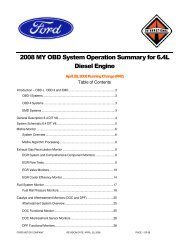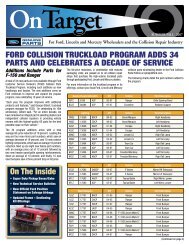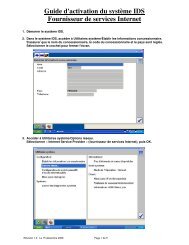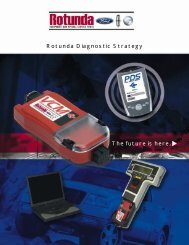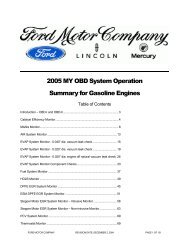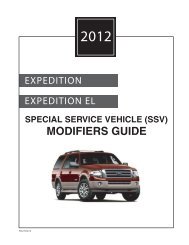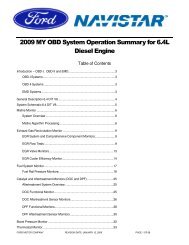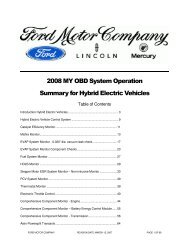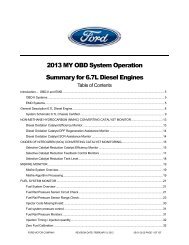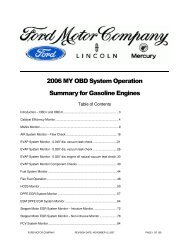2005 MY OBD System Operation Summary for Gasoline Engines
2005 MY OBD System Operation Summary for Gasoline Engines
2005 MY OBD System Operation Summary for Gasoline Engines
Create successful ePaper yourself
Turn your PDF publications into a flip-book with our unique Google optimized e-Paper software.
*> #606Exponentially Weighted Moving Averaging is a well-documented statistical data processing technique that is usedto reduce the variability on an incoming stream of data. Use of EWMA does not affect the mean of the data,however, it does affect the distribution of the data. Use of EWMA serves to “filter out” data points that exhibitexcessive and unusual variability and could otherwise erroneously light the MIL.The simplified mathematical equation <strong>for</strong> EWMA implemented in software is as follows:New Average = [New data point * “filter constant”] + [( 1 - “filter constant” ) * Old Average]This equation produces an exponential response to a step-change in the input data. The "Filter Constant"determines the time constant of the response. A large filter constant (i.e. 0.90 ) means that 90% of the new datapoint is averaged in with 10% of the old average. This produces a very fast response to a step change.Conversely, a small filter constant (i.e. 0.10 ) means that only 10% of the new data point is averaged in with 90%of the old average. This produces a slower response to a step change.When EWMA is applied to a monitor, the new data point is the result from the latest monitor evaluation. A newaverage is calculated each time the monitor is evaluated and stored in Keep Alive Memory (KAM). This normallyoccurs each driving cycle. The MIL is illuminated and a DTC is stored based on the New Average store in KAM.In order to facilitate repair verification and DDV demonstration, 2 different filter constants are used. A “fast filterconstant” is used after KAM is cleared/DTCs are erased and a “normal filter constant” is used <strong>for</strong> normalcustomer driving. The “fast filter” is used <strong>for</strong> 2 driving cycles after KAM is cleared/DTCs are erased, and then the“normal filter” is used. The “fast filter” allows <strong>for</strong> easy repair verification and monitor demonstration in 2 drivingcycles, while the normal filter is used to allow up to 6 driving cycles, on average, to properly identify a malfunctionand illuminate the MIL.In order to relate filter constants to driving cycles <strong>for</strong> MIL illumination, filter constants must be converted to timeconstants. The mathematical relationship is described below:Time constant = [ ( 1 / filter constant ) - 1 ] * evaluation periodThe evaluation period is a driving cycle. The time constant is the time it takes to achieve 68% of a step-change toan input. Two time constants achieve 95% of a step change input.FORD MOTOR COMPANY REVISION DATE: APRIL 28, 2004 PAGE 128 OF 131



